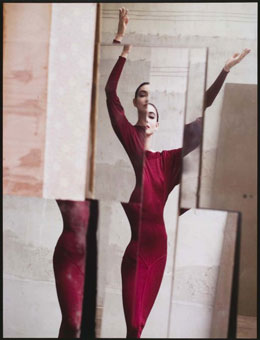3.6.24 — The Fashionista Himself
“I’m HIV positive. It doesn’t have to be negative.” So runs a magazine ad that David Seidner accompanied with his own photograph, of himself. Can his optimism withstand his dying and his anxiety over what he had become as an image maker?
The International Center of Photography opens with a self-portrait. Retrospectives often do, but Seidner was a fashion photographer first and foremost. It consumed pretty much the entirety of a sadly abbreviated life. Yet surely fashion photography is not about the photographer, right—and not about art? Such, at least, is convention, but his torn allegiance powered some provocative art, through March 6. You can only return to “ICP at 50” chastened and questioning. 
Photography is always about looking, through the camera and the human eye behind it. It is also about making you want to look—for photojournalism, at the urgency of breaking events. For fashion photography, that means making you look at a look that you will want for yourself. It is a work for hire about work for sale, and Seidner knew that, too. He snagged a contract, an exclusive contract, with Yves Saint Laurent. He loved it because photography for him was always about appearances, ones that he could manipulate and turn on himself.
Seidner in that self-portrait is lying down, seductive, provocative, and vulnerable. He turns the camera on other men as well, with an overlaid black grid. It defines his work as art back when the grid of late Modernism ruled. It also highlights the body and dismembers it. That can mean a naked body, a clothed body, or, in other work, a fragment of clothing alone. It is a polished image but also a teaser for what may never come.
He brings the same versatility to fashion. He directs the eye to the model and the designer, and he does not distinguish the two. A magazine feature about a designer requires no less. He elevates his subject while taking it apart and reassembling it, with multiple exposures and with mirrors. Nicely dressed store mannequins look more individual and alive than many a professional model. One can almost claim to know what they are thinking.
If that were not sufficiently a matter of art, Seidner devotes a series from the 1990s to well-known artists. Hung in four rows of four photos apiece, their unsmiling faces appear up close, approaching you and challenging you. Naturally he includes himself, as a boast but also in wonder as to whether he belongs. And then he is back with clothing, billowing outward. One hardly knows whether he has fallen prey more than ever to fashion or turned away from the model. The conventions and the fashion still turn me off, but they have me thinking.
An eye to appearances is also an eye on gender, and Seidner was gay. He died of AIDS in 1999, at forty-two. One might see his work as his coming out or anxiety about his identity. It has its parallel in art and anti-art photography of his time, like that the self-portrait as a pose for Cindy Sherman or dolls in place of mannequins for Laurie Simmons. It looks ahead to painting by women today that makes a point of the body but minimizes the self-questioning. I hardly know whether to call Seidner more or less radical for that.
He accords with the current interest not in minimizing fine art, but in refusing to set it apart from design and craft—no more than photography from painting. Museum shows of fashion are still mostly pandering, but the Jewish Museum has recovered magazine photography for art as well. ICP sees Seidner as long neglected but vital to its collection (pairing it with its fiftieth anniversary show, no less). It has his tear sheets, but it ends with something else again. A final series sets orchids in blurred close-up against a backdrop of fabric. It becomes pure color, but still an emblem of impending death.
Read more, now in a feature-length article on this site.